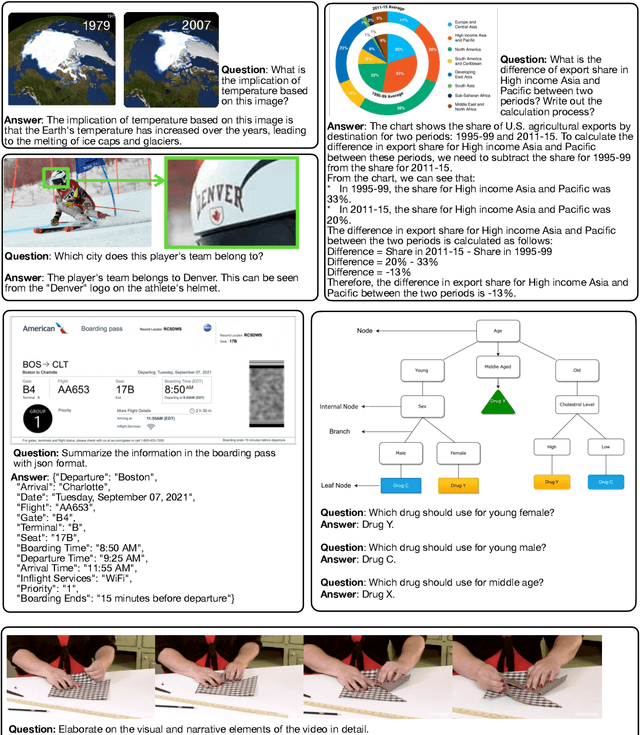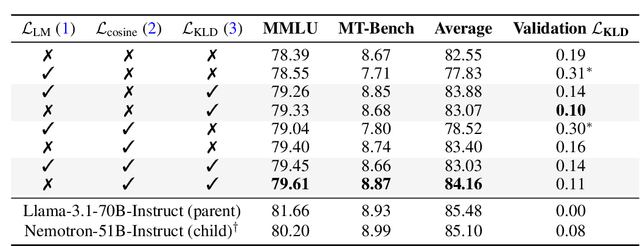Pavlo Molchanov
Efficient Hybrid Language Model Compression through Group-Aware SSM Pruning
Apr 15, 2025Abstract:Hybrid LLM architectures that combine Attention and State Space Models (SSMs) achieve state-of-the-art accuracy and runtime performance. Recent work has demonstrated that applying compression and distillation to Attention-only models yields smaller, more accurate models at a fraction of the training cost. In this work, we explore the effectiveness of compressing Hybrid architectures. We introduce a novel group-aware pruning strategy that preserves the structural integrity of SSM blocks and their sequence modeling capabilities. Furthermore, we demonstrate the necessity of such SSM pruning to achieve improved accuracy and inference speed compared to traditional approaches. Our compression recipe combines SSM, FFN, embedding dimension, and layer pruning, followed by knowledge distillation-based retraining, similar to the MINITRON technique. Using this approach, we compress the Nemotron-H 8B Hybrid model down to 4B parameters with up to 40x fewer training tokens. The resulting model surpasses the accuracy of similarly-sized models while achieving 2x faster inference, significantly advancing the Pareto frontier.
Nemotron-H: A Family of Accurate and Efficient Hybrid Mamba-Transformer Models
Apr 10, 2025Abstract:As inference-time scaling becomes critical for enhanced reasoning capabilities, it is increasingly becoming important to build models that are efficient to infer. We introduce Nemotron-H, a family of 8B and 56B/47B hybrid Mamba-Transformer models designed to reduce inference cost for a given accuracy level. To achieve this goal, we replace the majority of self-attention layers in the common Transformer model architecture with Mamba layers that perform constant computation and require constant memory per generated token. We show that Nemotron-H models offer either better or on-par accuracy compared to other similarly-sized state-of-the-art open-sourced Transformer models (e.g., Qwen-2.5-7B/72B and Llama-3.1-8B/70B), while being up to 3$\times$ faster at inference. To further increase inference speed and reduce the memory required at inference time, we created Nemotron-H-47B-Base from the 56B model using a new compression via pruning and distillation technique called MiniPuzzle. Nemotron-H-47B-Base achieves similar accuracy to the 56B model, but is 20% faster to infer. In addition, we introduce an FP8-based training recipe and show that it can achieve on par results with BF16-based training. This recipe is used to train the 56B model. All Nemotron-H models will be released, with support in Hugging Face, NeMo, and Megatron-LM.
Scaling Vision Pre-Training to 4K Resolution
Mar 25, 2025Abstract:High-resolution perception of visual details is crucial for daily tasks. Current vision pre-training, however, is still limited to low resolutions (e.g., 378 x 378 pixels) due to the quadratic cost of processing larger images. We introduce PS3 that scales CLIP-style vision pre-training to 4K resolution with a near-constant cost. Instead of contrastive learning on global image representation, PS3 is pre-trained by selectively processing local regions and contrasting them with local detailed captions, enabling high-resolution representation learning with greatly reduced computational overhead. The pre-trained PS3 is able to both encode the global image at low resolution and selectively process local high-resolution regions based on their saliency or relevance to a text prompt. When applying PS3 to multi-modal LLM (MLLM), the resulting model, named VILA-HD, significantly improves high-resolution visual perception compared to baselines without high-resolution vision pre-training such as AnyRes and S^2 while using up to 4.3x fewer tokens. PS3 also unlocks appealing scaling properties of VILA-HD, including scaling up resolution for free and scaling up test-time compute for better performance. Compared to state of the arts, VILA-HD outperforms previous MLLMs such as NVILA and Qwen2-VL across multiple benchmarks and achieves better efficiency than latest token pruning approaches. Finally, we find current benchmarks do not require 4K-resolution perception, which motivates us to propose 4KPro, a new benchmark of image QA at 4K resolution, on which VILA-HD outperforms all previous MLLMs, including a 14.5% improvement over GPT-4o, and a 3.2% improvement and 2.96x speedup over Qwen2-VL.
TwinTURBO: Semi-Supervised Fine-Tuning of Foundation Models via Mutual Information Decompositions for Downstream Task and Latent Spaces
Mar 10, 2025Abstract:We present a semi-supervised fine-tuning framework for foundation models that utilises mutual information decomposition to address the challenges of training for a limited amount of labelled data. Our approach derives two distinct lower bounds: i) for the downstream task space, such as classification, optimised using conditional and marginal cross-entropy alongside Kullback-Leibler divergence, and ii) for the latent space representation, regularised and aligned using a contrastive-like decomposition. This fine-tuning strategy retains the pre-trained structure of the foundation model, modifying only a specialised projector module comprising a small transformer and a token aggregation technique. Experiments on several datasets demonstrate significant improvements in classification tasks under extremely low-labelled conditions by effectively leveraging unlabelled data.
FeatSharp: Your Vision Model Features, Sharper
Feb 22, 2025Abstract:The feature maps of vision encoders are fundamental to myriad modern AI tasks, ranging from core perception algorithms (e.g. semantic segmentation, object detection, depth perception, etc.) to modern multimodal understanding in vision-language models (VLMs). Currently, in computer vision, the frontier of general purpose vision backbones are Vision Transformers (ViT), typically trained using contrastive loss (e.g. CLIP). A key problem with most off-the-shelf ViTs, particularly CLIP, is that these models are inflexibly low resolution. Most run at 224x224px, while the "high resolution" versions are around 378-448px, but still inflexible. We introduce a novel method to coherently and cheaply upsample the feature maps of low-res vision encoders while picking up on fine-grained details that would otherwise be lost due to resolution. We demonstrate the effectiveness of this approach on core perception tasks as well as within agglomerative model (RADIO) training as a way of providing richer targets for distillation.
Advancing Weight and Channel Sparsification with Enhanced Saliency
Feb 05, 2025



Abstract:Pruning aims to accelerate and compress models by removing redundant parameters, identified by specifically designed importance scores which are usually imperfect. This removal is irreversible, often leading to subpar performance in pruned models. Dynamic sparse training, while attempting to adjust sparse structures during training for continual reassessment and refinement, has several limitations including criterion inconsistency between pruning and growth, unsuitability for structured sparsity, and short-sighted growth strategies. Our paper introduces an efficient, innovative paradigm to enhance a given importance criterion for either unstructured or structured sparsity. Our method separates the model into an active structure for exploitation and an exploration space for potential updates. During exploitation, we optimize the active structure, whereas in exploration, we reevaluate and reintegrate parameters from the exploration space through a pruning and growing step consistently guided by the same given importance criterion. To prepare for exploration, we briefly "reactivate" all parameters in the exploration space and train them for a few iterations while keeping the active part frozen, offering a preview of the potential performance gains from reintegrating these parameters. We show on various datasets and configurations that existing importance criterion even simple as magnitude can be enhanced with ours to achieve state-of-the-art performance and training cost reductions. Notably, on ImageNet with ResNet50, ours achieves an +1.3 increase in Top-1 accuracy over prior art at 90% ERK sparsity. Compared with the SOTA latency pruning method HALP, we reduced its training cost by over 70% while attaining a faster and more accurate pruned model.
Entropy-Regularized Process Reward Model
Dec 15, 2024Abstract:Large language models (LLMs) have shown promise in performing complex multi-step reasoning, yet they continue to struggle with mathematical reasoning, often making systematic errors. A promising solution is reinforcement learning (RL) guided by reward models, particularly those focusing on process rewards, which score each intermediate step rather than solely evaluating the final outcome. This approach is more effective at guiding policy models towards correct reasoning trajectories. In this work, we propose an entropy-regularized process reward model (ER-PRM) that integrates KL-regularized Markov Decision Processes (MDP) to balance policy optimization with the need to prevent the policy from shifting too far from its initial distribution. We derive a novel reward construction method based on the theoretical results. Our theoretical analysis shows that we could derive the optimal reward model from the initial policy sampling. Our empirical experiments on the MATH and GSM8K benchmarks demonstrate that ER-PRM consistently outperforms existing process reward models, achieving 1% improvement on GSM8K and 2-3% improvement on MATH under best-of-N evaluation, and more than 1% improvement under RLHF. These results highlight the efficacy of entropy-regularization in enhancing LLMs' reasoning capabilities.
RADIO Amplified: Improved Baselines for Agglomerative Vision Foundation Models
Dec 10, 2024Abstract:Agglomerative models have recently emerged as a powerful approach to training vision foundation models, leveraging multi-teacher distillation from existing models such as CLIP, DINO, and SAM. This strategy enables the efficient creation of robust models, combining the strengths of individual teachers while significantly reducing computational and resource demands. In this paper, we thoroughly analyze state-of-the-art agglomerative models, identifying critical challenges including resolution mode shifts, teacher imbalance, idiosyncratic teacher artifacts, and an excessive number of output tokens. To address these issues, we propose several novel solutions: multi-resolution training, mosaic augmentation, and improved balancing of teacher loss functions. Specifically, in the context of Vision Language Models, we introduce a token compression technique to maintain high-resolution information within a fixed token count. We release our top-performing models, available in multiple scales (-B, -L, -H, and -g), alongside inference code and pretrained weights.
NVILA: Efficient Frontier Visual Language Models
Dec 05, 2024



Abstract:Visual language models (VLMs) have made significant advances in accuracy in recent years. However, their efficiency has received much less attention. This paper introduces NVILA, a family of open VLMs designed to optimize both efficiency and accuracy. Building on top of VILA, we improve its model architecture by first scaling up the spatial and temporal resolutions, and then compressing visual tokens. This "scale-then-compress" approach enables NVILA to efficiently process high-resolution images and long videos. We also conduct a systematic investigation to enhance the efficiency of NVILA throughout its entire lifecycle, from training and fine-tuning to deployment. NVILA matches or surpasses the accuracy of many leading open and proprietary VLMs across a wide range of image and video benchmarks. At the same time, it reduces training costs by 4.5X, fine-tuning memory usage by 3.4X, pre-filling latency by 1.6-2.2X, and decoding latency by 1.2-2.8X. We will soon make our code and models available to facilitate reproducibility.
Puzzle: Distillation-Based NAS for Inference-Optimized LLMs
Dec 03, 2024



Abstract:Large language models (LLMs) have demonstrated remarkable capabilities, but their adoption is limited by high computational costs during inference. While increasing parameter counts enhances accuracy, it also widens the gap between state-of-the-art capabilities and practical deployability. We present Puzzle, a framework to accelerate LLM inference on specific hardware while preserving their capabilities. Through an innovative application of neural architecture search (NAS) at an unprecedented scale, Puzzle systematically optimizes models with tens of billions of parameters under hardware constraints. Our approach utilizes blockwise local knowledge distillation (BLD) for parallel architecture exploration and employs mixed-integer programming for precise constraint optimization. We demonstrate the real-world impact of our framework through Llama-3.1-Nemotron-51B-Instruct (Nemotron-51B), a publicly available model derived from Llama-3.1-70B-Instruct. Nemotron-51B achieves a 2.17x inference throughput speedup, fitting on a single NVIDIA H100 GPU while preserving 98.4% of the original model's capabilities. Nemotron-51B currently stands as the most accurate language model capable of inference on a single GPU with large batch sizes. Remarkably, this transformation required just 45B training tokens, compared to over 15T tokens used for the 70B model it was derived from. This establishes a new paradigm where powerful models can be optimized for efficient deployment with only negligible compromise of their capabilities, demonstrating that inference performance, not parameter count alone, should guide model selection. With the release of Nemotron-51B and the presentation of the Puzzle framework, we provide practitioners immediate access to state-of-the-art language modeling capabilities at significantly reduced computational costs.
 Add to Chrome
Add to Chrome Add to Firefox
Add to Firefox Add to Edge
Add to Edge